Environment: milieu / climate zone / depth range / distribution range
Ecologie
marien; brak water demersaal; oceanodroom (Ref. 51243); diepte 10 - 50 m (Ref. 114953). Subtropical; 43°N - 23°N (Ref. 114953)
Northwest Pacific: central China to northern Japan.
Lengte bij maturiteit / Grootte / Gewicht / Leeftijd
Maturity: Lm 44.0 range ? - ? cm
Max length : 200 cm TL mannelijk / geslacht onbekend; (Ref. 637); common length : 100.0 cm TL mannelijk / geslacht onbekend; (Ref. 637); max. gepubliceerd gewicht: 10.7 kg (Ref. 40637)
Disc rhomboid, anterior margin straight, posterior margin convex. Snout triangular and slightly produced. dorsal keel present on tail. Adults with small spines on disc and posterior part of tail. Brown dorsally and some with orangish pectoral fin margins, in front of eyes, behind spiracles, on the sides of the tail just anterior to the sting. Ventrum orangish red.
Found in coral reefs and estuarine areas, on sand and mud bottoms (Ref. 12951, 11230). Feeds on small fishes and crustaceans (Ref. 9840). Ovoviviparous with litters of only 1 pup (Ref. 114953) while earlier estimates indicated production of up to 10 in a litter (Ref. 12951). Caught occasionally by bottom trawl fisheries operating inshore. Utilized for its meat but of limited value due to its small size (Ref.58048). Served in 'miso' soup, hard boiled with seasonings, or for 'kamaboko' material (Ref. 637).
Exhibit ovoviparity (aplacental viviparity), with embryos feeding initially on yolk, then receiving additional nourishment from the mother by indirect absorption of uterine fluid enriched with mucus, fat or protein through specialised structures (Ref. 50449). Distinct pairing with embrace (Ref. 205).
Last, P.R., W.T. White, M.R. de Carvalho, B. Séret, M.F.W. Stehmann and G.J.P. Naylor, 2016. Rays of the world. CSIRO Publishing, Comstock Publishing Associates. i-ix + 1-790. (Ref. 114953)
Status op de Rode Lijst van het IUCN (Ref. 130435)
Gebruik door de mens
Visserij: commercieel; Aquarium: Commercieel
Meer informatie
ReferentiesAquacultuurAquacultuurprofielKweeklijnenGeneticaElectrophoresesErfelijkheidZiektesVerwerkingNutrientsMassaconversie
Tools
Speciale rapporten
Download XML
Internetbronnen
Estimates based on models
Preferred temperature (Ref.
123201): 21.4 - 29, mean 28.1 °C (based on 510 cells).
Fylogenetische diversiteitsindex (Ref.
82804): PD
50 = 0.5010 [Uniqueness, from 0.5 = low to 2.0 = high].
Bayesian length-weight: a=0.00646 (0.00265 - 0.01571), b=3.06 (2.86 - 3.26), in cm total length, based on LWR estimates for this (Sub)family-body shape (Ref.
93245).
Trofisch niveau (Ref.
69278): 3.8 ±0.58 se; based on food items.
Weerstandsvermogen (Ref.
120179): laag, minimale populatieverdubbelingstijd 4,5-14 jaar (K=0.1; Fec=1).
Fishing Vulnerability (Ref.
59153): Very high vulnerability (90 of 100).
Climate Vulnerability (Ref.
125649): Very high vulnerability (87 of 100).
